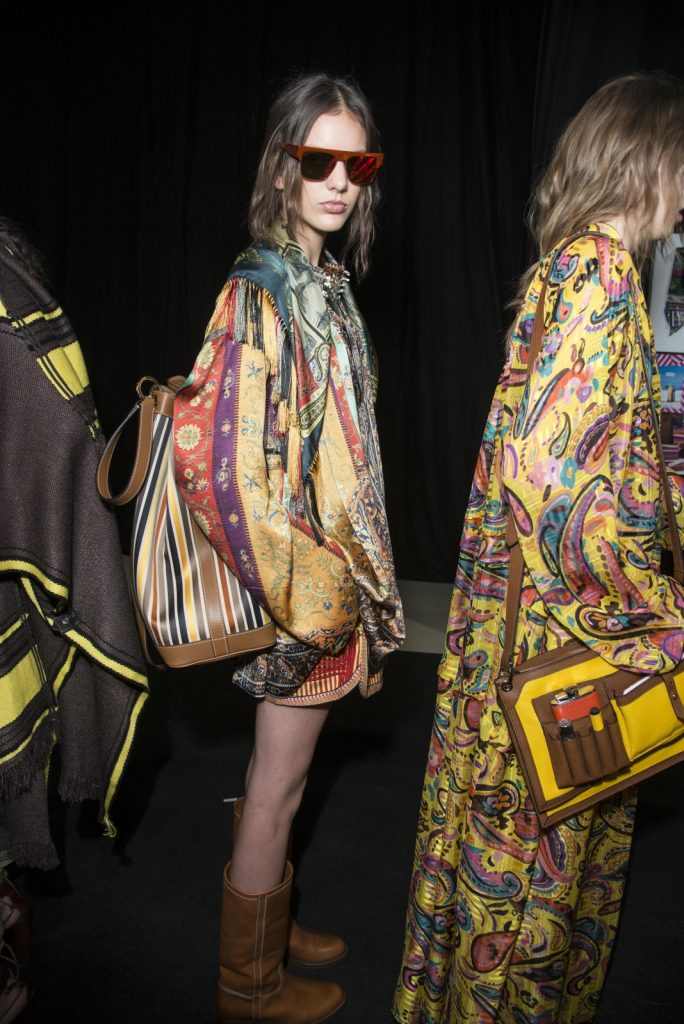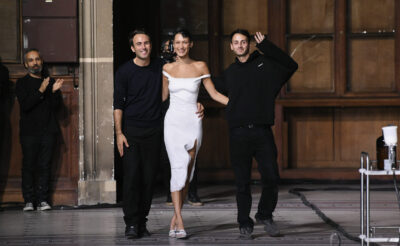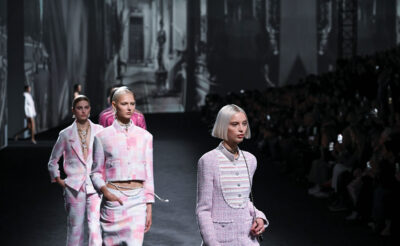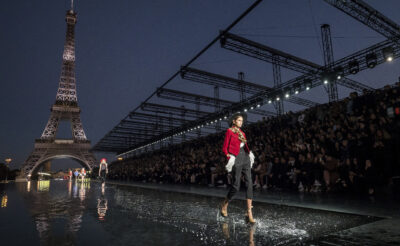Unashamedly opulent in detailed textures and exquisite fabrics, the timeless appeal of the Paisley print was once again apparent in the spring/summer17 shows. In a rich cross-cultural exchange, Acne Studios layered the design on soft, flowing silks, printed in teal and tangerine upon kaftans and Baja jackets.
Jonny Johansson drew his inspiration from the ongoing refugee crisis, considering the textile traditions of the countries ‘where many have been displaced’. “It is interesting to me that even though we live in a digital age with a free flow of information, there are many countries who want to close their borders,” the designer said. “I prefer to focus on openness and looking out into the world.” Oscar de la Renta also gravitated towards this globalised aesthetic, with embroidered overcoats punctuated by patches of monochrome paisley, and the print, which is now ubiquitous to the brand, prevailed throughout Etro’s kaleidoscopic collection. It’s been upheld as the ‘century-long fashion’, enduring the industry’s fickle tendencies. Many associate the mesmeric curves of the design with Indian Mughul culture or its namesake, Paisley in Scotland, but the print can actually be traced back to Shiraz’s Masjid-e Nasir-ol- Molk mosque. It’s a common misconception, as current discussion surrounding fashions in Iran often comes with a side of political subtext.
Since the 1979 Revolution, sartorial stories are dominated by emerging designers proposing clothing that fulfills religious obligations rather than breaking new ground, but the country’s fashion credentials run so much deeper. What is less talked about is the immense interplay between Persian culture and high fashion. Your high heels were first thought up by Iranian equestrians, who wore block heels to fix their feet into stirrups, while the word pyjama, or pay-jameh, refers to a loose-legged garment worn by men and women – the term was first coined in Iran. Kaftans, khakis, shawls, and pashminas are also products of Persian culture that continue to underpin and inspire our wardrobes today.
Since the 1979 Revolution, sartorial stories are dominated by emerging designers proposing clothing that fulfills religious obligations rather than breaking new ground, but the country’s fashion credentials run so much deeper.
Perhaps most captivating of all are Iran’s prints, the most prolific being Paisley. “The motif originally went by the name boteh [the Persian word meaning shrub] and originated millennia ago. It’s been likened to many shapes in nature, both real and imaginary: lotus, mango, leech, yin-yang, dragon, and cypress pine,” explains Jude Stewart, author of Patternalia. The print’s story began during the 15th Century, when Kashmiri ruler Zain-ul-Abidin enticed weavers from Persia and Central Asia to Kashmir, to produce shawls decorated in the boteh design. “These prized shawls featured prominently in a ritual known as khil’at, a robes of honour exchange between dignitaries during political- ceremonial visits,” says Stewart. Objects of immense desire, the shawls took an enormous amount of time to produce with rare raw materials, including the fine-spun wool that came from shahtoosh goats living high in the Himalayan mountains.
The print eventually crossed over into Europe during the late 18th century, when Kashmiri princes began including officers from the British East India Company in their shawl-giving rituals. Europe’s attempts at machine-made shawls never met the luxurious standards of the originals, but the trend amongst Europeans prevailed with Paisley, Scotland, becoming the leading producer, lending its name to the pattern itself. Skip forward to the Swinging Sixties, and yet more attention came to the design. Immigration from Asian countries where the print was prevalent collided with Europe’s zeitgeist for psychedelia, and Paisley’s swirling shapes soon became the staple associated with youth culture at that time. Since the Nineties, Paisley has appreciated regular acclaim. For spring/ summer12, Stella McCartney and J W Anderson adorned pajamas with its curves, while Lebanese couturier, Rani Zakhem, inflated the design to dramatic proportions. “Our spring/summer16 couture collection used a beautiful Paisley print chiffon from the acclaimed fabric manufacturer, Hurel,” Zakhem enthuses. “The chiffon base was black, with Paisley in gold lurex thread.”
Other prints of importance include ‘Cintamani’, a design closely aligned with the Ottoman and Persian empires. The pattern made from circles and wavy stripes is said to represent flaming pearls, but in Ottoman culture, it’s referred to as tiger stripes and leopard spots. Symbolising strength and courage, the pattern became a go-to motif informing Buddhist, Hindu and Islamic design. “It practically served as the corporate logo of the Ottoman empire for centuries,” notes Stewart.
Immigration from Asian countries where the print was prevalent collided with Europe’s zeitgeist for psychedelia, and Paisley’s swirling shapes soon became the staple associated with youth culture
One-of-a-kind, rarified Persian rugs enjoy their esteemed position as one of the most complex and labour-intensive handcrafts. In recent years, luxury fashion has called upon this tradition. Known for taking commonplace objects and reappropriating them for fashion’s purposes, Maison Margiela made the Persian rug the overriding theme for its spring/summer12 collection. Silk slip-dresses and skirts formed the shape of carpets wrapped around bodies, while shawls were covered in sequins in the unique patterns of Oriental rugs. In 2013, Hermès named their collection ‘Tabriz’ after the Iranian city; the designs drew upon Persian miniatures and rug designs. And, more recently in 2015, Riccardo Tisci gave both menswear and womenswear the rich Iranian treatment. Givenchy’s autumn/ winter collection embedded traditional textile motifs upon ruby-hued velvet dresses, while menswear took a more literal approach, placing carpet patterns squarely onto T-shirts, trainers, coats and trousers for overall impact.
The relationship between Europe and Iran is complex, to say the least, but in a time where powers seek to draw lines of distinction between cultures, fashion is one way of marrying them. More than just a trend in time, Iran’s exotic appeal endures, as today’s collections continue to capture Persia’s superb craftsmanship and storied history. Sadly, often passed off as Indian produce, Paisley prevails with one foot in the past and another in the present. And, while the lineage of the print might have become lost in translation, what unites the designs of Margiela and Tisci is a sense of narrative. By choosing to perpetuate the Persian rug, their designs reflect the historicism, value and sophistication of an age-old artistry. It’s a means to express our contemporary mood and fashion’s continued fascination with foreign culture.




